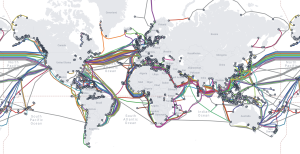Starlink: The Revolutionary Satellite Constellation Changing the Face of Global Connectivity
Starlink is a satellite constellation developed by SpaceX, a private aerospace manufacturer and space transport services company founded by Elon Musk. The project aims to provide high-speed, low-latency internet connectivity worldwide, especially in areas where traditional internet infrastructure is lacking or non-existent. With its cutting-edge technology and ambitious goals, Starlink is set to revolutionize the way we access and utilize the internet.
At the forefront of the Starlink project is its focus on providing global connectivity. By launching a constellation of low-Earth orbit satellites, SpaceX intends to create a network that can deliver fast and reliable internet services to even the most remote areas of the world. This is particularly significant for communities in developing countries, where access to the internet is often limited or non-existent. With Starlink, these communities can now bridge the digital divide and participate in the global digital economy.
How Starlink Works
Starlink’s technology is based on a constellation of small satellites, each about the size of a car, orbiting the Earth at an altitude of approximately 550 kilometers. These satellites are equipped with advanced communication equipment, including transceivers and antennas, which enable them to transmit and receive data signals. The satellites are connected to a network of ground stations, which are responsible for managing the flow of data between the satellites and the internet.
When a user sends a request for data, such as loading a website or sending an email, the request is transmitted to the nearest Starlink satellite, which then forwards the request to the nearest ground station. The ground station then connects to the internet and retrieves the requested data, which is then transmitted back to the satellite and finally to the user’s device. This process happens in a matter of milliseconds, thanks to the low latency of the Starlink network.
Benefits of Starlink
The benefits of Starlink are numerous and far-reaching. For one, it provides access to high-speed internet in areas where traditional internet infrastructure is lacking. This can have a significant impact on communities, enabling them to access educational resources, healthcare services, and economic opportunities that were previously out of reach. Additionally, Starlink’s low latency and high-speed connectivity make it an attractive option for applications that require real-time communication, such as online gaming, video conferencing, and remote work.
Starlink also has the potential to bridge the digital divide, which refers to the gap between those who have access to the internet and those who do not. By providing internet access to underserved communities, Starlink can help to promote digital inclusion and social equity. Furthermore, the project can also contribute to the development of rural areas, where access to the internet can be a major factor in economic growth and development.
Impact and Future Developments
The impact of Starlink on the world is already being felt, with the project having launched thousands of satellites into orbit since its inception. As the constellation continues to grow, we can expect to see even more significant advancements in global connectivity. SpaceX has announced plans to launch up to 42,000 satellites as part of the Starlink project, which will provide unparalleled coverage and capacity.
In addition to its impact on global connectivity, Starlink is also driving innovation in the field of space technology. The project has pushed the boundaries of what is possible with satellite technology, and its advancements are being closely watched by the space industry. As the project continues to evolve, we can expect to see new and exciting developments in areas such as satellite design, launch technology, and space-based communications.


